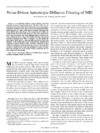Identificador persistente para citar o vincular este elemento:
https://accedacris.ulpgc.es/jspui/handle/10553/76890
| Campo DC | Valor | idioma |
|---|---|---|
| dc.contributor.author | Krissian, Karl | en_US |
| dc.contributor.author | Aja-Fernández, Santiago | en_US |
| dc.date.accessioned | 2020-12-21T14:29:58Z | - |
| dc.date.available | 2020-12-21T14:29:58Z | - |
| dc.date.issued | 2009 | en_US |
| dc.identifier.issn | 1057-7149 | en_US |
| dc.identifier.other | WoS | - |
| dc.identifier.uri | https://accedacris.ulpgc.es/handle/10553/76890 | - |
| dc.description.abstract | A new filtering method to remove Rician noise from magnetic resonance images is presented. This filter relies on a robust estimation of the standard deviation of the noise and combines local linear minimum mean square error filters and partial differential equations for MRI, as the speckle reducing anisotropic diffusion did for ultrasound images. The parameters of the filter are automatically chosen from the estimated noise. This property improves the convergence rate of the diffusion while preserving contours, leading to more robust and intuitive filtering. The partial derivative equation of the filter is extended to a new matrix diffusion filter which allows a coherent diffusion based on the local structure of the image and on the corresponding oriented local standard deviations. This new filter combines volumetric, planar, and linear components of the local image structure. The numerical scheme is explained and visual and quantitative results on simulated and real data sets are presented. In the experiments, the new filter leads to the best results. | en_US |
| dc.language | eng | en_US |
| dc.relation.ispartof | IEEE Transactions on Image Processing | en_US |
| dc.source | Ieee Transactions On Image Processing [ISSN 1057-7149], v. 18 (10), p. 2265-2274, (Octubre 2009) | en_US |
| dc.subject | 32 Ciencias médicas | en_US |
| dc.subject | 3314 Tecnología médica | en_US |
| dc.subject.other | Anisotropic Diffusion | en_US |
| dc.subject.other | LMMSE Filter | en_US |
| dc.subject.other | Magnetic Resonance Imaging | en_US |
| dc.subject.other | Rician Distribution | en_US |
| dc.title | Noise-Driven Anisotropic Diffusion Filtering of MRI | en_US |
| dc.type | info:eu-repo/semantics/Article | en_US |
| dc.type | Article | en_US |
| dc.identifier.doi | 10.1109/TIP.2009.2025553 | en_US |
| dc.identifier.pmid | 19546041 | - |
| dc.identifier.scopus | 70349604349 | - |
| dc.identifier.isi | 000269715500010 | - |
| dc.contributor.authorscopusid | 6602218913 | - |
| dc.contributor.authorscopusid | 6507904679 | - |
| dc.identifier.eissn | 1941-0042 | - |
| dc.description.lastpage | 2274 | en_US |
| dc.identifier.issue | 10 | - |
| dc.description.firstpage | 2265 | en_US |
| dc.relation.volume | 18 | en_US |
| dc.investigacion | Ingeniería y Arquitectura | en_US |
| dc.type2 | Artículo | en_US |
| dc.contributor.daisngid | 1202623 | - |
| dc.contributor.daisngid | 453969 | - |
| dc.description.numberofpages | 10 | en_US |
| dc.utils.revision | Sí | en_US |
| dc.contributor.wosstandard | WOS:Krissian, K | - |
| dc.contributor.wosstandard | WOS:Aja-Fernandez, S | - |
| dc.date.coverdate | Octubre 2009 | en_US |
| dc.identifier.ulpgc | Sí | en_US |
| dc.contributor.buulpgc | BU-MED | en_US |
| dc.description.jcr | 2,848 | |
| dc.description.jcrq | Q1 | |
| dc.description.scie | SCIE | |
| item.grantfulltext | open | - |
| item.fulltext | Con texto completo | - |
| crisitem.author.fullName | Krissian , Karl | - |
| Colección: | Artículos | |
Citas SCOPUSTM
191
actualizado el 08-jun-2025
Citas de WEB OF SCIENCETM
Citations
165
actualizado el 08-jun-2025
Visitas
179
actualizado el 12-jul-2025
Descargas
498
actualizado el 12-jul-2025
Google ScholarTM
Verifica
Altmetric
Comparte
Exporta metadatos
Los elementos en ULPGC accedaCRIS están protegidos por derechos de autor con todos los derechos reservados, a menos que se indique lo contrario.
